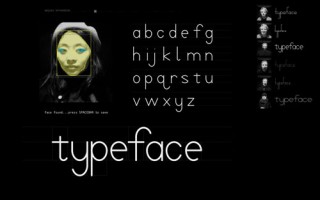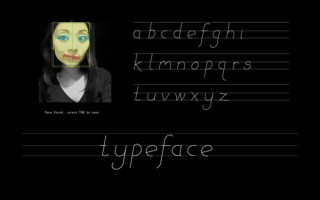Chloe – LookingOutwards02
BALL MAZE BY DAVID THOMASSON
Using the newly released LeapMotion, Ball Maze use the ‘Leap Motion For Processing’ library from voidplus in Processing on the laptop, which talks to Arduino in the maze. I admire this project for its tangibility, breaking the boundaries between the real and the digital, making for a much more intuitive gaming interface. The smoothness of the board’s movement really surprises me, as I have played with the LeapMotion before and found that even on the screen, it can be a bit glitchy.
TYPEFACE BY MARY HUANG


TYPEFACE is a study of facial recognition and type design, creating a typeface that corresponds to each individual, like a typographic portrait. As a communication design student, this project pushes at a lot of my buttons. There is a lot of talk about content driving form, the message defining the medium, etc. This is especially true for things that concern branding and identity, the most effective ones allowing for variation across many platforms while still maintaining a general level of quality and cohesion throughout. At the same time, for there to be a human touch in the formation of the type despite its digital interface shows yet again another wonderful example of bridging the gaps between humans and technologies.
EYES ON THE SKY BY JED CARTER
“I believe that most people respond more intuitively to simple colours than to the complex units of data found in weather reports and downloadable apps. My phone can instantly inform me of the current temperature outside in degrees of Celsius, but this reading tells me nothing of how warm or cold it actually feels. How warm is 18°C, exactly? Does that mean I need a jumper or a coat? We can access a multitude of different kinds of data relating to the weather, but can this information be used to create something beautiful or intuitive to read?”
Jed Carter used 64 public-access web cameras across Europe, recording the colour of the sky, at each point, at regular intervals and produced a book that collects a week of paintings where cameras paint the weather, once every hour. Processing was used to map RGB values collected from the photos to geographic locations, rendering a huge sequence of color maps of the sky.
With the erratic weather that has been plaguing my health and sanity this week, I find myself appreciating the quiet poetry of this work. Although it took me a while to figure out how exactly his system worked and to let go of the disconnect of the final product from its initial driving idea, I think it is in itself a beautiful artifact. I would love to see this idea of enhancing weather data using intuitive colors, with plays on the HSB scale depending not just on temperature, but how that temperature is changed with windchill, humidity, etc. It certainly would have helped with me wearing the right things this weird week and helped me avoid getting sick!